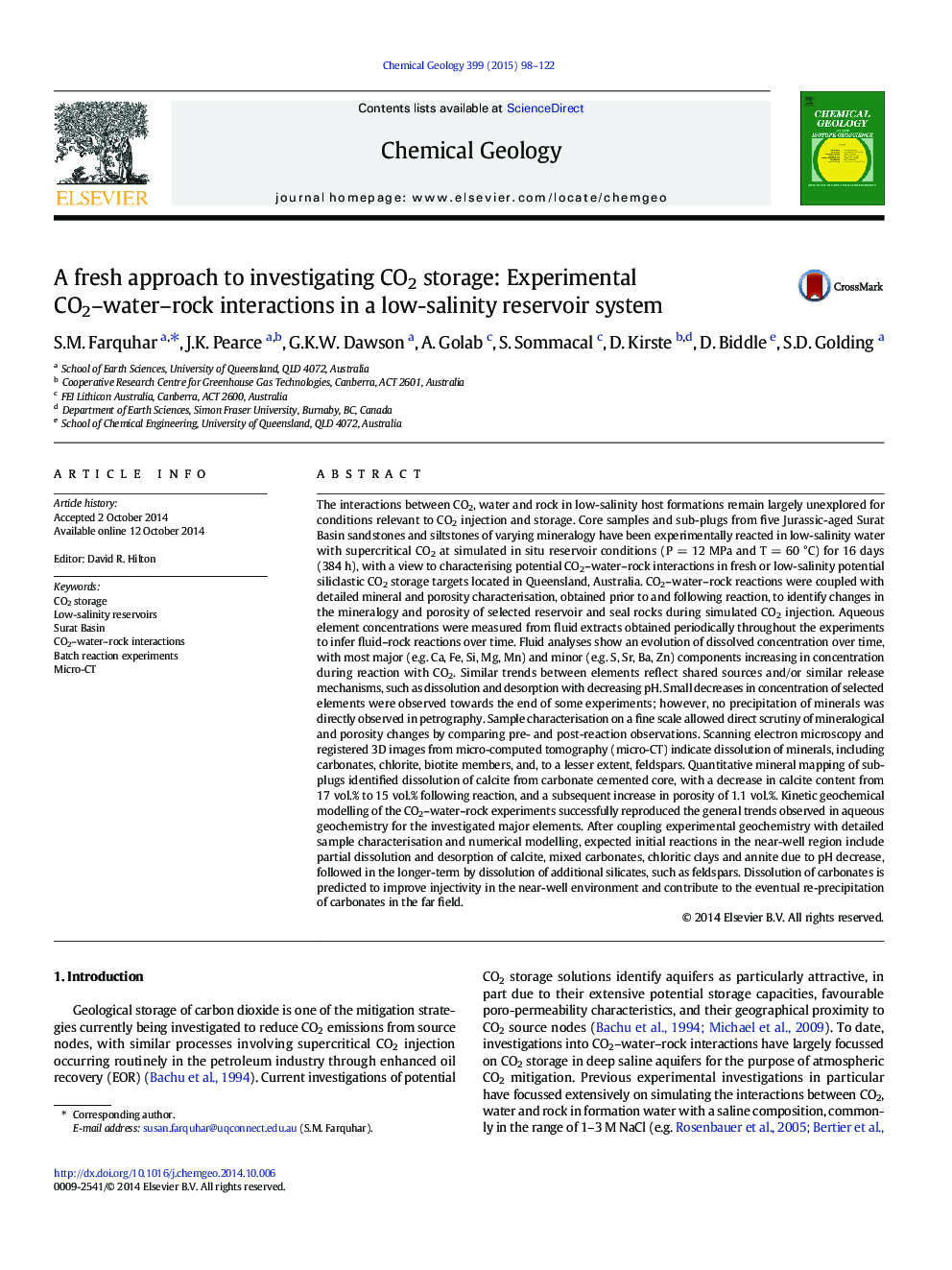| کد مقاله | کد نشریه | سال انتشار | مقاله انگلیسی | نسخه تمام متن |
|---|---|---|---|---|
| 4698600 | 1637574 | 2015 | 25 صفحه PDF | دانلود رایگان |

• CO2 batch-reaction experiments were conducted at simulated storage conditions.
• Whole-rock samples of varied mineralogy from a low-salinity reservoir were examined.
• Detailed sample characterisation was conducted pre- and post-CO2 to note changes.
• Experiments were coupled with micro-computed tomography and kinetic modelling.
• Fluid chemistry and petrography reveal dissolution of carbonates and some silicates.
The interactions between CO2, water and rock in low-salinity host formations remain largely unexplored for conditions relevant to CO2 injection and storage. Core samples and sub-plugs from five Jurassic-aged Surat Basin sandstones and siltstones of varying mineralogy have been experimentally reacted in low-salinity water with supercritical CO2 at simulated in situ reservoir conditions (P = 12 MPa and T = 60 °C) for 16 days (384 h), with a view to characterising potential CO2–water–rock interactions in fresh or low-salinity potential siliclastic CO2 storage targets located in Queensland, Australia. CO2–water–rock reactions were coupled with detailed mineral and porosity characterisation, obtained prior to and following reaction, to identify changes in the mineralogy and porosity of selected reservoir and seal rocks during simulated CO2 injection. Aqueous element concentrations were measured from fluid extracts obtained periodically throughout the experiments to infer fluid–rock reactions over time. Fluid analyses show an evolution of dissolved concentration over time, with most major (e.g. Ca, Fe, Si, Mg, Mn) and minor (e.g. S, Sr, Ba, Zn) components increasing in concentration during reaction with CO2. Similar trends between elements reflect shared sources and/or similar release mechanisms, such as dissolution and desorption with decreasing pH. Small decreases in concentration of selected elements were observed towards the end of some experiments; however, no precipitation of minerals was directly observed in petrography. Sample characterisation on a fine scale allowed direct scrutiny of mineralogical and porosity changes by comparing pre- and post-reaction observations. Scanning electron microscopy and registered 3D images from micro-computed tomography (micro-CT) indicate dissolution of minerals, including carbonates, chlorite, biotite members, and, to a lesser extent, feldspars. Quantitative mineral mapping of sub-plugs identified dissolution of calcite from carbonate cemented core, with a decrease in calcite content from 17 vol.% to 15 vol.% following reaction, and a subsequent increase in porosity of 1.1 vol.%. Kinetic geochemical modelling of the CO2–water–rock experiments successfully reproduced the general trends observed in aqueous geochemistry for the investigated major elements. After coupling experimental geochemistry with detailed sample characterisation and numerical modelling, expected initial reactions in the near-well region include partial dissolution and desorption of calcite, mixed carbonates, chloritic clays and annite due to pH decrease, followed in the longer-term by dissolution of additional silicates, such as feldspars. Dissolution of carbonates is predicted to improve injectivity in the near-well environment and contribute to the eventual re-precipitation of carbonates in the far field.
Journal: Chemical Geology - Volume 399, 2 April 2015, Pages 98–122